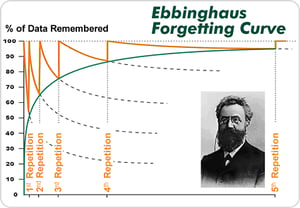
Minimize the Training Forgetting Curve
The goal of training is to impart the information employees need to improve job performance and productivity in their roles. While learners were engaged during the session, how much of the information will they retain and be able to put into action in their daily jobs? A challenge all training professionals face is that is once a training event is over, the amount of information retained will decline over time. This has been documented in the Ebbinghaus Forgetting Curve.
Ebbinghaus Forgetting Curve
 The Forgetting Curve, developed by Hermann Ebbinghaus in 1885 based on experiments with his own memory, suggests that as soon as a learning event is completed, participants will start forgetting the material. The decline in memory is sharp immediately after the event and continues over time.
The Forgetting Curve, developed by Hermann Ebbinghaus in 1885 based on experiments with his own memory, suggests that as soon as a learning event is completed, participants will start forgetting the material. The decline in memory is sharp immediately after the event and continues over time.
After one hour, people retain less than half of the information presented. After one day, they forget more than 70%, and after six days 75% of the information in the training.1
Some of the factors that influence the Forgetting Curve include:
- Difficulty of the material
- Relevance of the information – is it theoretical or can it be applied practically to the role
- Presentation – People have different learning styles: visual, auditory or kinesthetic
- Physical condition of the learner – are they stressed or sleep-deprived during training
High Cost of Forgetting
According to Training Magazine’s 2017 Training Industry Report, the total 2017 U.S. training expenditures rose significantly, increasing 32.5% to $90.6 billion.2 That is a large amount of money to spend when learners are not retaining material, meaning that training events are not meeting the knowledge and skill gaps or business objectives they were designed to address.
So how do you minimize the Forgetting Curve and improve the return on training investment?
Download 4 Ways to Curb the Forgetting Curve and start building out training that sticks.
For more insight into building training courses that stick, get in touch with the corporate training experts at TrainingFolks today.
Image: P2PU.org

